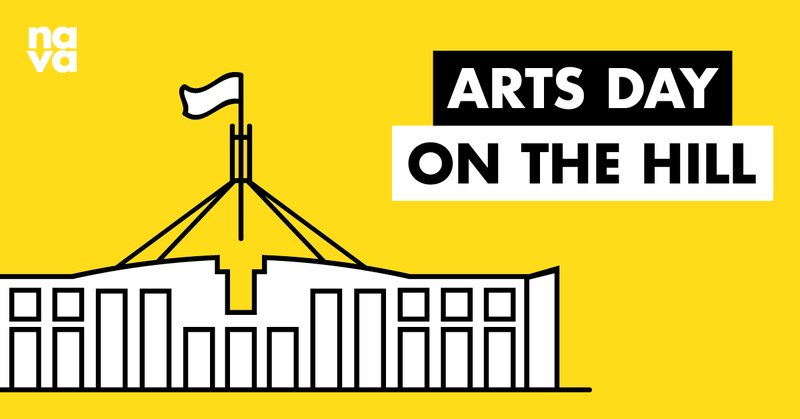Arts Day on the Hill
On 12 August, let’s hear from artists and artsworkers all over Australia in this year’s Arts Day on the Hill.
On 12 August, let’s hear from artists and artsworkers all over Australia in this year’s Arts Day on the Hill.

There’s a clear message for this year’s Arts Day on the Hill: unprecedented times call for unprecedented thinking. Given our conventional thinking did little to prepare us for this pandemic, it’s time to get creative. Which makes right now a critical time to invest in creative expertise.
We’ve heard a great deal during this crisis about the central importance of the arts industry to the Australian economy.
We know that creative experiences inspire 98% of all Australians.
We know that there are some 48,000 practising professional artists in Australia, 57,477 people employed in the arts, and 600,000 people employed in the broader $111.7bn cultural and creative activity sector.
With international borders closed and interstate travel constrained, regional arts tourism will be a key driver for each state’s recovery, with galleries and studio visits in high demand.
We know that tourism and hospitality rely on arts and culture for their own success, especially in regional areas. And we know that arts tourists are high-value visitors: they travel further, stay longer and spend more than domestic tourists overall.
We know that for every $1m in turnover the arts and entertainment sector creates nine jobs, as opposed to just one in mining or 0.36 in oil and gas extraction. And yet we keep hearing about a gas-led recovery – it just doesn’t make sense.
We also know that the arts was the first and worst-hit industry, and the one that will take the longest to recover.
So how can we power the creative sector to drive Australia’s recovery?
On 12 August, let’s hear from artists and artsworkers all over Australia in this year’s Arts Day on the Hill.
Let’s start with JobKeeper and JobSeeker. NAVA has been calling for their extension for months now, and it’s important to see that extension implemented. But the payment reduction is precipitous and the jobseeking expectation unrealistic. The arts sector has experienced alarming drops in payroll job numbers and has a high rate of casualisation.
In the visual arts, 42% of workers in the small-to-medium sector are casual, according to a recent report commissioned by NAVA: S2M: The economics of Australia’s small-to-medium visual arts sector.
And when we look at practising professional artists across all artforms, 30% are employed casually for their arts-related work, and 35% are employed casually for their non-arts-related work.
According to the Australian Bureau of Statistics, 33.9% of casual employees in arts and recreation services have been with their current employer for less than 12 months – and more than 12 months’ employment is a requisite for JobKeeper. In the arts, this is a mark of success; artists, curators, installers and so on aren’t working on a show at the same gallery every year, for example, but responding to demand from all over Australia.
Despite consistent industry calls, nothing has been done to make JobKeeper accessible to more casual workers.
Artists may have invented the gig economy and the portfolio career – but they didn’t master more agile ways of working to have that co-opted into workplace flexibilities that exploit casualisation and dismiss expertise.
Nor have any income support measures been made available to local governments or universities. Local governments are Australia’s major owner of art galleries and performing arts centres. Universities are major employers of artists and arts experts, also own galleries and performing arts centres, and are home to Australia’s leading art schools.
According to the National Public Galleries Alliance’s latest report, local government owns or operates 51% of Australia’s public galleries, with another 13% within universities. That’s 64% of Australia’s non-profit non-commercial galleries with no COVID-19 income support: no Cashflow Boost, no JobKeeper, nothing.
And when we add to this the compounding effects of massive fee increases for arts and humanities courses, we see a concerning move away from supporting the pathways that nurture the creative thinking needed to rescue us from this prolonged crisis.
What’s the No 1 skillset needed for the workforce and economy of the future? A wealth of global research, from the World Economic Forum to PWC, Deloitte, McKinsey, Nesta, Harvard, and even the Australian government’s Bureau of Communications and Arts Research agree: it’s creativity.
The Australian Government’s $160m rescue package for the arts has been welcomed by the industry. It’s a great start alongside JobKeeper, which has allowed a great many organisations to maintain relationships with expert staff at this critical time.
But that package only addresses some artform sectors and is focused on the creation and touring of new work, as opposed to supporting artists and the industry to survive and thrive through this crisis.
Victorian galleries, museums, studios and other venues have just been through the expensive turmoil of closing, opening and closing again and, as with other states, the Victorian government has offered targeted package after package to support the arts.
What’s needed now is an ambitious national vision that invests in arts and culture comprehensively and empowers its professional pathways. And that means investing in creative education, arts tourism, the creative industry across all artforms and scales, and creative workers no matter where and how they’re employed. Because we need their thinking, we need their inspiration and we need their boost to our economy.
As the Victorian experience demonstrates, the path to recovery will not be a linear one. Let’s test our assumptions, reset our expectations and fire up our creative imagination.
It’s time to think adventurously about the Australia we’d like to see emerge from this crisis.